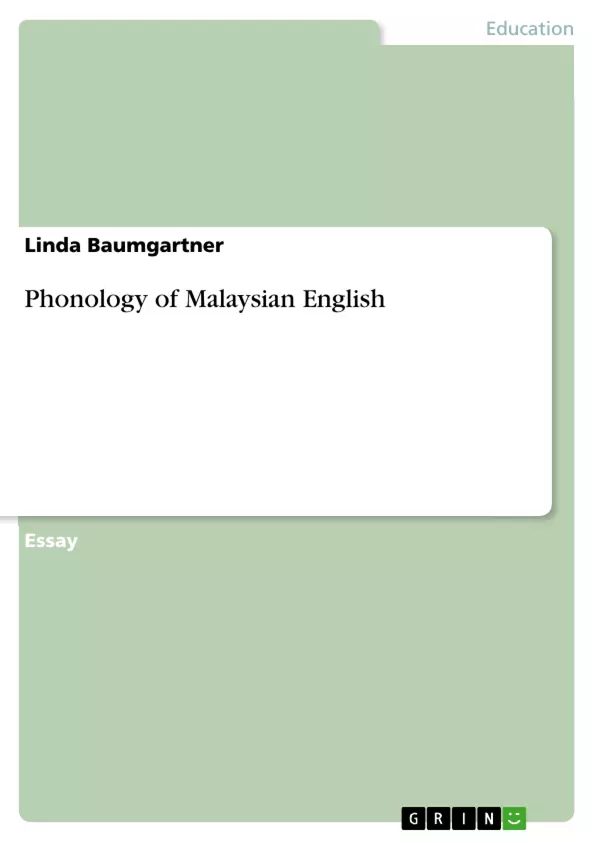This essay deals with the influence British invaders had on the language spoken in Malaysia and carefully scrutinizes the phonology of Malaysian English, which is compared to RP and shows differences in vowel- and consonant production and in suprasegmental and phonotactic features.
Inhaltsverzeichnis (Table of Contents)
- Introduction
- Vowels
- Vowel length
- Vowel quality
- Diphthongs
- Triphthongs
- Consonants
- Consonant cluster reduction
- Consonant substitution
- Fricatives
- Dental Fricatives
- Glottalisation
- Suprasegmental features
- Stress
- Stress position
- Stress quantity
- Rhythm
- Intonation
- Stress
- Phonotactic features
- Gradation
- Liaison
- Syllabicity
- Conclusion
Zielsetzung und Themenschwerpunkte (Objectives and Key Themes)
This essay aims to provide an overview of the phonological features of Malaysian English (MalE) and contrast them with Received Pronunciation (RP). The essay begins with a brief overview of Malaysia's history and cultural background, setting the context for the development of MalE. It then explores the specific phonological features of MalE, including vowel length, vowel quality, consonant cluster reduction, consonant substitution, and suprasegmental features.
- The influence of Bahasa Malaysia on the phonology of MalE.
- The role of MalE as a neutral lingua franca in a multicultural society.
- The distinctive features of MalE vowels, including vowel length and quality.
- The impact of consonant cluster reduction and substitution on MalE phonology.
- The significance of suprasegmental features such as stress, rhythm, and intonation in MalE.
Zusammenfassung der Kapitel (Chapter Summaries)
The introduction provides a historical and cultural background of Malaysia, explaining the development of Malaysian English as a result of British colonization and the influence of various substrate languages. It highlights the role of English as a second language in Malaysia and the cultural diversity that makes English a neutral lingua franca.
The chapter on vowels discusses the smaller vowel inventory of MalE compared to RP, attributing this to the lack of distinction between traditional vowel pairs. It analyzes the tendency to shorten long vowels in MalE, potentially influenced by Bahasa Malaysia's lack of long vowels. The chapter also examines the phenomenon of lengthening short vowels in MalE, particularly in front of certain consonants. The lack of contrast between long and short vowels is shown to lead to homophones, potentially causing misunderstandings.
The chapter on vowel quality explores how MalE vowel quality differs from RP. Studies show that certain vowels in MalE are realized as more open and centralized compared to RP. The chapter further analyzes the lack of distinction between vowel pairs in MalE, presenting research findings on the realization of vowel pairs as single vowels.
Schlüsselwörter (Keywords)
Malaysian English, phonology, vowel length, vowel quality, consonant cluster reduction, consonant substitution, suprasegmental features, stress, rhythm, intonation, Bahasa Malaysia, lingua franca, cultural diversity.
- Quote paper
- Linda Baumgartner (Author), 2011, Phonology of Malaysian English, Munich, GRIN Verlag, https://www.grin.com/document/179802



